Past Exhibition
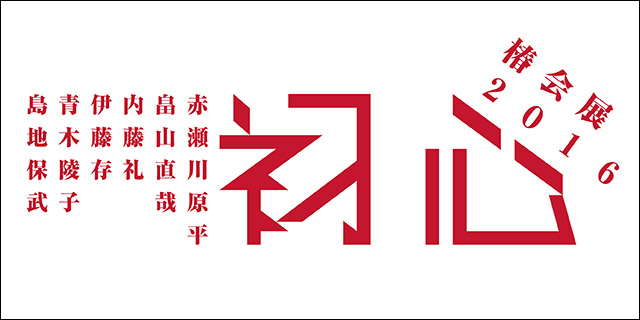
The Shiseido Gallery is pleased to announce the exhibition Tsubaki-kai 2016 —Shoshin (beginner's mind), to run from April 28 (Thu) through June 19th (Sun), 2016. The Tsubaki-kai, an exhibition group formed originally in 1947 and with a membership that has continually changed over the past years, is one of the Shiseido Gallery's most important flagship group exhibitions.
The Seventh Tsubakikai was formed in 2013 by Genpei Akasegawa, Naoya Hatekeyama, Rei Naito, Zon Ito, and Ryoko Aoki, with plans to exhibit together once a year through 2017. The thematic subtitle “Shoshin (beginner's mind)” was chosen with reference to the recovery efforts that followed the 2011 Great Tohoku Earthquake, with the group feeling these invited opportunities to reconsider what it means to “start over” and “begin things anew.” The Shinmeikai Japanese Dictionary defines “shoshin” as “the purity of thought and feeling experienced when first engaging or attempting something.” The Noh master Zeami, in his treatises on art, urged the importance of “never forgetting the beginner's mind” and describes this as a mental stance useful in confronting new experiences of all kinds throughout the various stages of life.
Reflecting the idea of renewal, graphic designer Masayoshi Nakajo has also been recreating and renewing the Tsubaki-kai exhibition logo each year.
This exhibition is the fourth for these participating Tsubaki-kai group. Yasutake Shimaji, a dancer and choreographer, joined the group from the last exhibition, and his membership marks the Tsubaki-kai's first inclusion an artist from the field of dance. For this exhibition he will be presenting works of sculpture (a new medium for him) accompanied by dance perfromances scheduled during the exhibition period. Naoya Hatekeyama, who spent September last year through this February in Mexico as a representative of the Japanese Agency for Cultural Affairs, will present landscape photographs shot during his stay. Rei Naito will continue the “color beginning” painting series she gave title for Tsubaki-kai 2013 exhibition, with new two- and three-dimensional works. Zon Ito will present animations of drawings based on his observations and surveys of insects and other living creatures dwelling in and around Tokyo's Ginza district. Ryoko Aoki will present a “zine” made out of communication with the other Tsubaki-kai members, as well as her own original works. Finally, the works by the late Genpei Akasegawa will be exhibited. This year, we will show pen-and-ink drawings from the 1970s. The Shiseido Gallery invites one and all to come experience this inspiring lineup of newly created and selected works that continue the Tsubaki-kai's exploration of “Shoshin.”
Simultaneously with the Tsubakikai presentations, three other Shiseido properties (the Shiseido Ginza Building, SHISEIDO THE GINZA, and the Tokyo Ginza Shiseido Building) will be presenting photographic works by Shinzo Fukuhara (Shiseido Gallery founder, photography enthusiast, and first Shiseido president) and his younger brother Roso Fukuhara.
■Exhibiting Members
| Genpei Akasegawa (1937–2014) |
Born in Yokohama in 1937. Lived in Tokyo. Akasegawa was a painter, author, illustrator, avant-garde artist, founding member of the Street Observers Society, and defendant of the famous “1000-Yen Bill Incident.” In 1981 he won the 84th Akutagawa Literary Prize for his short story My father vanished (written under the pseudonym Katsuhiko Otsuji). In 1989 he collaborated with Hiroshi Teshigahara on the screenplay for the film Rikyu, which won a Best Screenplay Award from the Japan Academy. Akasegawa's published works include: The Riddle of Mr. Shinkai (Bunshun Library); Hyper-Art Thomasson; The Power of the Old (Chikuma Library); World is filled with Coincidences (Chikuma Shobo); and Leica's Good, But I want watches (C's-Factory). A phrase from the Japanese title of The Power of the Old even entered the popular lexicon in 1998. Akasegawa's most recent exhibitions have included Overflowing Images: Printed Media & Arts After the Anti-Art 1960s–70s (2008) at the Urawa Museum of Art; Akasegawa Genpei's Sampo no Shukaku (2010) at Yokohama City Public Gallery Azamino; TOKYO 1955–1970 / Avant-garde Arts (2012–13) at the Museum of Modern Art in New York; Hi-Red Center: The Documents of Direct Action (2013) at the Nagoya City Art Museum and the Shoto Museum of Art; Katsuhiko Otsuji × Genpei Akasegawa: A Polyhedron of Literature & Art (2014) at Machida City Kotoba Land; and Genpei Akasegawa's Principles of Art: 1960s–Present (2014–15) at the Chiba City Art Museum, Oita Art Museum, and Hiroshima City Museum of Contemporary Art. |
|---|---|
| Naoya Hatakeyama | Born in Rikuzentakata, Iwate in 1958. Lives in Tokyo. Hatakeyama studied photography under Kiyoji Otsuji at the University of Tsukuba's School of Art and Design, completing postgraduate studies there in 1984. Since then he has been based in Tokyo, focusing on photographic series showing the relationships between nature, cities, and photography. In 2001 Hatakeyama exhibited along with Masato Nakamura and Yukio Fujimoto in the Japanese Pavilion at the 49th Venice Biennale. His work has been shown in numerous solo and group exhibitions in Japan and abroad, including Naoya Hatakeyama: Natural Stories at the Tokyo Metropolitan Museum of Photography (2011) for which he the Minister of Education, Culture, Sports, Science, and Technology's Art Encouragement Prize of Fine Arts. In 2012, he participated in the Japanese Pavilion at the Venice Biennale's 13th International Architecture Exhibition (earning the Leone d'Oro award) . From September 2915 to February 2016, he spent five months in Mexico as a representative of the Japanese Agency for Cultural Affair. |
| Rei Naito | Born in Hiroshima in 1961. Lives in Tokyo. Naito earned a degree in visual communication design from the College of Art and Design, Musashino Art University in 1985. She gained recognition for One Place on the Earth at the Sagacho Exhibit Space in 1991, and she later showed this work in the Japanese Pavilion at the 47th Venice Biennale in 1997. Her major solo exhibitions have included: Migoto ni harete otozureru wo mate at the National Museum of Art, Osaka (1995); Being Called at the Galerie im Karmeliterkloster, Frankfurt am Main (1997); Giving Back at the Asahi Beer Oyamazaki Villa Museum, Kyoto (2005); matrix at the Nizayama Forest Art Museum, Toyama (2007); Tout animal est dans le monde comme de l' eau à l' intérieur de l' eau at the Museum of Modern Art, Kamakura (2009); and the emotion of belief at the Tokyo Metropolitan Teien Art Museum(2014). Permanent work include Being given at Kinza, an Art House Project, Naoshima, Kagawa (2001) and matrix at the Teshima Art Museum (2010). In 2015 she published Rei Naito 1985-2015 Blessing (Millegraph), a retrospective book at her work over the last thirty years. |
| Zon Ito | Born in Osaka in 1971. Lives in Kyoto. Ito graduated from Kyoto City University of Arts in 1996. He has presented a variety of styles of work including embroidered textiles, animation, drawing, and sculpture. His domestic and international exhibitions have included: The End of the Neighborhood at the WATARI-UM, the Watari Museum of Contemporary Art, Tokyo (2003); Three Individuals at the National Museum of Art, Osaka (2006); Louisa Bufardeci & Zon Ito at the Museum of Contemporary Art, Sydney (2009); Primary Field II at the Museum of Modern Art, Hayama (2010–11); Ways of Worldmaking at the National Museum of Art, Osaka (2011); Beppu mimicry (KASHIMA 2012 BEPPU ARTIST IN RESIDENCE), Oita (2012); Now Japan at KAdE Kunsthal, Amersfoort (2013–14); and Isobe-yu Gallery/Isobeyu Bathhouse Restoration Project, Maebashi (2013); Unknown City – Inside Out at Gallery Fleur, Kyoto (2015); Yama/Kanzenban no Ikiiki Center at Kyoto City University of Arts Gallery (2015); SOMETHINKS at Art Lab Hashimoto, Sagamihara (2015); Two Sticks at the think Tank Lab Triennale, Wrocław, Poland (2015-16). |
| Ryoko Aoki | Born in Hyogo in 1973. Lives in Kyoto. MFA in visual design from Kyoto University of Fine Art in 1999. Aoki's works are often comprised of sketches of a variety of images including plants and animals, fragments of daily life, and geometric patterns. Her major solo exhibitions have included: CRITERIUM 51 at Art Tower Mito, Ibaraki (2002); HAMMER PROJECT Ryoko Aoki at the UCLA Hammer Museum, Los Angeles (2005–06); and Seeds of Wildflower at On Sundays, Tokyo (2010). Her major group exhibitions have included: Documenta 12 in Kassel (2007); The Door into Summer: The Age of Micropop at Art Tower Mito, Ibaraki (2007); Winter Garden at the Hara Museum of Contemporary Art, Tokyo (2009); Garden of Painting: Japanese Art of the 00s at the National Museum of Art, Osaka (2010); You reach out –right now- for something: Questioning the Concept of Fashion at Art Tower Mito and the Marugame Genichiro-Inokuma Museum of Contemporary Art (2014); and Chronicals 1995– for the 20th Anniversary MOT Special Collection at the Museum of Contemporary Art, Tokyo (2014); For Troedsson Villa at the Troedsson Villa in Nikko (2015); Wabi Sabi Shima, from the aesthetic of Perfection and Chaos in the Japanese archipelago at the Thalie Art Foundation, Brussels (2015); Contemporary tales from the province – Susaki artist in residence, Susaki, Kochi (2015); and Two Sticks at the think Tank Lab Triennale Wrocław, Poland (2015-16). |
| Yasutake Shimaji | Born in Nagano in 1978. Lives in Kanagawa. Shimaji studied in the Theater Arts Department at Nihon University College of Art. He began studying modern dance under Miyako Kato, and later spent 2004 to 2006 as a member of Noism in the city of Niigata. In August 2006 he joined The Forsythe Company (led by William Forsythe) in Frankfurt, where he remains an active member until 2015. In 2013 Shimaji formed the Altneu “dance unit” with fellow dancer Hana Sakai. He returned to Japan in 2015 and produced and choreograph Layerings of Color for Noism2. He also established the Shimaji Project and invited two of his fellow Forsythe Company dancers to perform glimpse-appearance and disappearnce at the Hara Museum of Contemporary Art and Shinso/Kyusoku (physical dance performance/repose) at the Museum of Modern Art, Kamakura & Hayama. Additional credits include performances with Altneu at the Museum of Modern Art, Shinso/Kioku (physical dance performance/memory) in Kamakura and Shinso/Shiten (physical dance performance/starting point) in Hayama, and Chikamatsu reporters at the New National Theatre, Tokyo. In April 2016 Shimaji collaborates with Tamaki ROY on Arika. |
■Reference photos: from the Tsubaki-kai 2015 exhibition
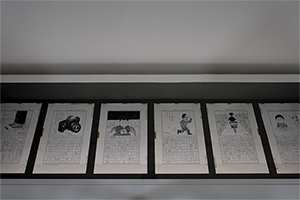
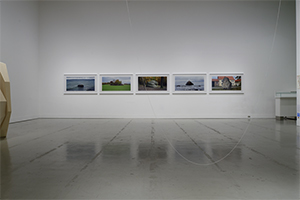
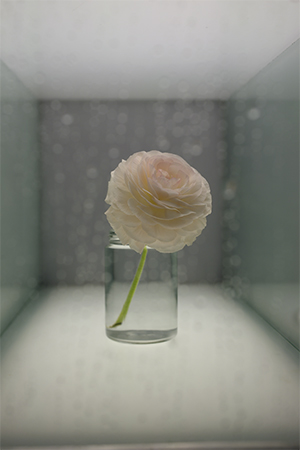
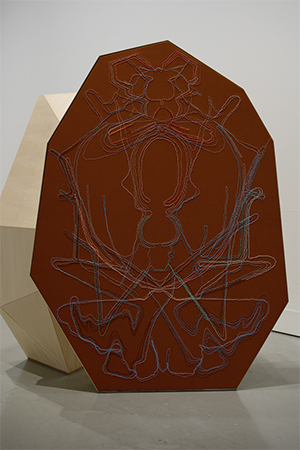
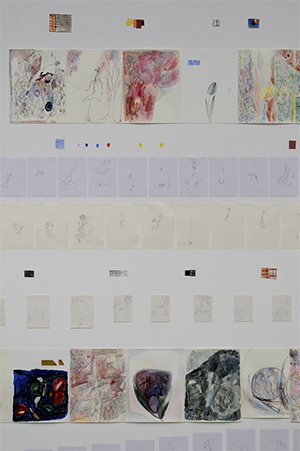
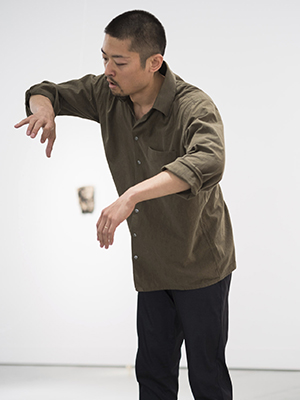
Photos ①〜⑤ by Naoya Hatekeyama; photo ⑥ by Ken Kato
■Exhibition Details for Tsubaki-kai 2016 — Shoshin
| Organized by Shiseido Co., Ltd. | |
| Duration: | April 28 (Thu) to June 19 (Sun), 2016 |
| Location: |
The Shiseido Gallery Tokyo Ginza Shiseido Building, B1, 8-8-3 Ginza, Chuo-ku, Tokyo 104-0061 Tel:03-3572-3901; Fax:03-3572-3951 |
| Hours: |
Weekdays: 11:00 AM - 7:00 PM, Sundays and National Holidays: 11:00 AM - 6:00 PM Closed on Monday (including public holidays) |
| Admission is free | |